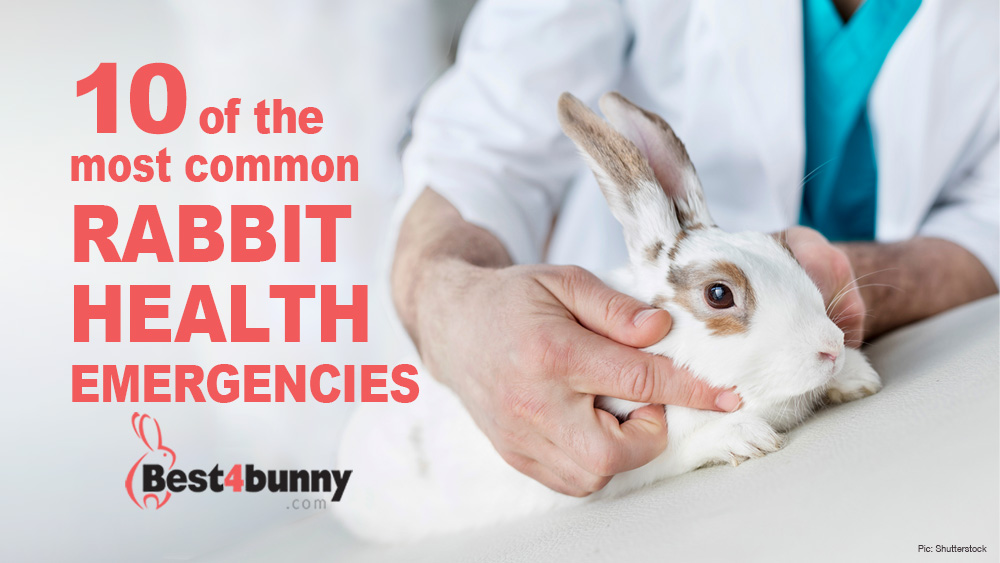
Rabbits are very different to dogs and cats, because an illness that may not be serious for a dog or cat can be life threatening for a rabbit. This means that it is important for rabbit owners to be able to quickly recognise the signs of serious illness, so appropriate treatment can be provided.
This article will take you through 10 of the most common rabbit emergencies enabling you to recognise the signs so that you can seek prompt veterinary care for your pet if they do become unwell or injured. If you are concerned about the health of your rabbit then you should always contact your veterinary practice for advice.
1. Inappetence and small or no faecal pellets
Unlike dogs and cats the smallest change in your rabbit’s appetite can indicate illness. This can be as simple as change in the food they prefer to eat or can result in a rabbit completely refusing all food. You may also see that the size of their faecal pellets have reduced or they may even stop passing faecal pellets completely.
Gastrointestinal stasis
The change in appetite and faecal pellet signs indicate that the rabbit is suffering from gastrointestinal stasis (gut stasis), which is where the rabbit’s digestive system slows down. This can be due to a number of different health issues.
Rabbits rely on the constant movement of food throughout the gut and any change to this can have serious consequences to the health of the rabbit. Gut stasis is a life threatening condition that can lead to rabbits deteriorating within hours, so it requires urgent veterinary treatment.
Dental disease
Dental disease is one of the common causes of gut stasis, which results in your rabbit’s mouth being too painful for them to eat. You may find that your rabbit shows additional signs including, dribbling, wet fur around the mouth or discharge from the eyes. Dental disease is a life-long condition that will need dental investigations to determine the severity but before this can be performed your rabbit will need veterinary treatment to correct the gut stasis.
2. Flystrike
Now the weather is starting to improve, you will see an increase in the number of flies that are around. This means that the risk of your rabbit suffering from flystrike will be increasing. This risk is higher for elderly or overweight rabbits and those with health issues.
Flystrike is a condition where flies are attracted to a rabbit, usually as the result of a wound or caecotroph accumulation around the rabbit’s rear end. The flies will lay eggs on the rabbit and these go onto hatch into maggots, sometimes within a matter of hours. It is the maggots that cause damage the rabbit’s skin and unless prompt veterinary treatment is given, flystrike can quickly become fatal.
Prevention of flystrike
All rabbits should be checked twice a day to make sure that they are clean and that there are no wounds present. If you find that your rabbit is struggling to keep themselves clean then you should seek veterinary advice so that any underlying health problems can be identified and corrected.
For further protection you should frequently clean out your rabbit’s house, making sure that urine and faeces are removed daily. Using fly traps near to your rabbit’s house can also be useful to help try and reduce fly numbers around your rabbit.
Both rabbits kept outdoors and inside can be affected by flystrike, so it is important that all rabbits are checked for signs and preventative measures are taken. Rabbits with an increased risk of developing flystrike may also require the use of a preventative flystrike treatment, so you should ask your vet for advice on a suitable treatment.
3. Bleeding or severe wounds
Small wounds or minor bleeding (a slight ooze) can sometimes be managed at home by keeping the affected area clean twice daily with salt water. However, severe wounds or injuries resulting in heavy blood loss will require emergency veterinary treatment. Due to a rabbits small size, even a small amount of blood loss can be life-threatening for a rabbit, so if in doubt contact you vet for advice.
Wounds
Wounds that are deep, cover a large area or are puncture wounds (a penetrating wound that may not look big but can cause damage deep below the skin) will require veterinary treatment. Other signs that the wound may need treatment include, discharge from the wound, bleeding, a foreign body, or if your rabbit is showing any additional signs of being unwell. If you are unsure if a wound requires further treatment then you should always seek veterinary advice.
Bleeding
Unless the bleeding is minimal, such as oozing from a broken nail that stops after a couple of minutes, your rabbit will need veterinary attention. If possible, you should apply gentle pressure to the area, using a clean cloth, to stem the blood flow while you contact your vets.
Serious blood loss may be seen as a fast flow of blood, or blood is soaking the cloth you are using to apply pressure. In these cases emergency treatment is required as this condition can quickly become life-threatening.
4. Fractures
Rabbits can fracture (break) bones as the result of suffering a traumatic injury or fall. Some rabbits will also be suffering from an underlying condition that weakens their bones making them more likely to fracture.
Fractures are painful so regardless of the cause, if you suspect that your rabbit is suffering from a fracture or has had a traumatic injury then emergency veterinary care is needed so appropriate treatment can be given.
5. Attack by a predator
Rabbits are a prey animal, and our pet rabbits have a number of predators that may try to attack them. Even a friendly dog may get too playful and cause your rabbit an injury.
Every rabbit who has been attacked by another animal should be taken to the vets to be checked. This is because rabbits can quickly go into shock after a traumatic event and it can also be difficult to see the level of injury that has occurred to your pet, as they may have internal damage, fractured bones, or even blood loss.
6. Pain
As a prey animal, rabbits will try to hide any signs of illness and pain. This means that you may have to look for subtle changes in your rabbit’s behaviour to detect that they are unwell. Often a rabbit in pain will be lethargic (quiet) and may sit in a hunched position. They will be less inquisitive than normal, and may not want to interact with you.
In more severe cases, you may also hear a painful rabbit grinding their teeth or even scream, which always requires emergency veterinary care.
7. Respiratory distress
Rabbits are nasal breathers, so a healthy rabbit will always breathe through their nose. However, rabbits can suffer from a number of respiratory issues that need to be recognised quickly so treatment can be provided.
Open mouth breathing
If you see your rabbit breathing through their mouth then this always requires emergency veterinary treatment. The rabbit will be in a distressed state so you should keep calm and minimise handling your rabbit to decrease their stress.
Heat stroke can result in open mouth breathing, so if your suspect that your rabbit has got too hot then you should try to cool them down during transporting them to the vets. At the same time you need to be careful not to get them too cold and send them into shock. Using air conditioning in the car, spraying their ears and feet with cool (not cold) water and minimising handling can be useful.
Signs of respiratory illness
Rabbits can commonly develop respiratory conditions, which can make them unwell if not treated. Some respiratory conditions can also affect rabbits throughout their life, so they can be prone to recurrent episodes of illness.
Signs of respiratory illness may include, noise when breathing, an increased breathing effort, nasal discharge or even open mouth breathing. If you notice any of these signs then you should phone you veterinary practice for advice.
8. Diarrhoea
Dogs and cats may not always need treatment for diarrhoea but rabbits are different and due to their sensitive digestive system signs of diarrhoea can be serious. There are many different causes that will result in a rabbit developing diarrhoea, including infectious causes and using certain antibiotics in rabbits. Diarrhoea is most common in young rabbits but every rabbit showing signs of diarrhoea should be provided with veterinary treatment.
If your rabbit is suffering from diarrhoea then they will not be producing any hard pellets and you may see loose watery faeces or large amounts of soft faeces that can sometimes contain blood. You may also see other signs of illness including, lethargy or abdominal pain and these rabbits are also at risk of developing dehydration.
9. Neurological signs
Rabbits can show a number of different neurological (nervous system) signs including, a head tilt, uncoordinated movement, paralysis or seizures (fitting). There are many different causes for these signs including, encephalitozoonosis (E. cuniculi) and other infectious diseases, trauma, poisoning and tumours. The severity of the signs can vary but all rabbits showing any neurological signs will need veterinary care.
Seizures
It can be very distressing for an owner to witness their pet having a seizure. If you do find your rabbit during a seizure then you should try not to handle them but you can remove any nearby items that may cause them injury. A seizuring rabbit will need to be taken to a vets, so when transporting your rabbit you should pad out their carrier using soft bedding and towels to protect them. Time is important for these cases as if a rabbit continues to seizure then their temperature can increase to dangerous levels, so it is important to contact your vets promptly.
10. Urinating blood
Blood in your rabbit’s urine can be a sign of an underlying illness so you should contact your veterinary practice for advice if you notice any blood in your rabbit’s urine. It is also important to be aware that a healthy rabbit’s urine can vary in colour and can commonly have a reddish colour. This colour will be found throughout the urine, whereas blood in the urine will usually be seen as spots or patches of blood, making it possible to distinguish between the two types.
Written by Lisa Butwell
Author Bio: ‘I am a veterinary surgeon for small animals and I graduated from Liverpool University in 2015. I enjoy all aspects of small animal work but I am particularly interested in rabbit medicine. Currently, I live in Cheshire with my 2 friendly French Lop rabbits called Spot and Buddy, a Cocker Spaniel called Molly and 3 recently acquired rescue hens.
For more health advice on rabbits visit the Best4bunny Health pages here



